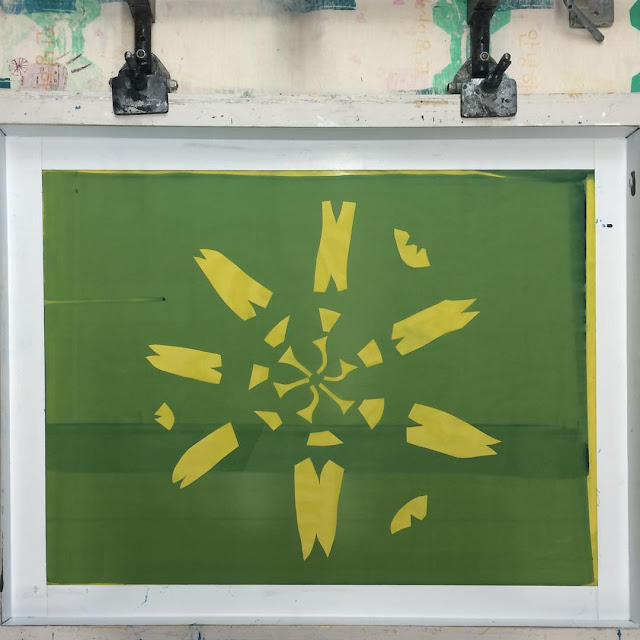 |
| "Toile" at Women's Studio Workshop: Silk screen on muslin with machine stitched details. |
"Toile" is the title of my recent exhibition of works created at Women's Studio Workshop.
In sewing terminology "Toile" is another word for a muslin, which is a test version of a pattern for a garment. "Toile" and "muslin" can also refer to the fabric used to make such a test version.
 |
| Title of the exhibition with a bowl of vegetable muslins: acorn squash, onion, and mushroom. |
The sewn objects in the exhibition were patterned using draping techniques on vegetables. The pattern pieces were then used as the inspiration for silkscreen prints on muslin and brown paper.
 |
| Garlic toiles (two versions) with the original hand drawn pattern on muslin. |
In creating this work, I played with different arrangements of the pattern pieces. In the end I chose to work with a radial arrangement because it echoed the almost symmetrical, radial pattern of the subject. The form also alludes to a star or mandala.
 |
| Garlic pattern, print on muslin fabric. About 12 inches wide. |
The prints have three layer that refer back the process of patterning. The first layer (printed in solid white) is the actual shape of the pattern pieces. The second layer, printed in a not quite black, is the hand drawn shape on muslin, that refers back to the process of draping. The third layer (red) is in some cases a registration mark where corners of the pattern would join, or an indication of where sewn details should be added. For example, in the garlic pattern, the red line indicates the indentations between the cloves of the garlic head, which would be sewn and pulled slightly to gather inward.
 |
| Detail of garlic print, showing the three layers of the print. |
One interesting aspect of these patterns is that they are made from individual vegetables with unique forms. The pattern attempts to capture and reproduce this unique form, in a manner that is almost nostalgic. However, unlike a photograph or even the print itself, the pattern is imperfect, and each handmade object is unique, adding an entirely different layer of variation.
 |
| Pepper muslin and print on muslin fabric |
 |
| Detail of pepper print. |
 |
| Acorn squash muslin and print on muslin. |
The prints on muslin and brown paper recall the tactile materials of pattern making. While any fabric could technically be used to make a "muslin," muslin fabric is often the fabric of choice because it has predictable qualities and is inexpensive. It also serves as a "blank canvas" for the designer's idea in two ways-- it provides little distraction allowing the designer to imagine different colors and textures that might be used in the final product, and it also allows markings in different colors to be clearly visible.
Similarly, any paper could be used to make test patterns. In fact, there is no clear standard that I know of, with some designers preferring some form of tracing paper or even sewable tracing paper, while other designers will use anything convenient. Brown butcher or kraft paper is often used for its neutrality and low cost.
 |
| Prints on paper: Acorn Squash, Shitake Mushroom, Onion |
While I was tempted to print on butcher paper, I ended up using a brown kraft-look cardstock by French's paper since it accepted the silkscreen inks in a more predictable way.
 |
| Acorn Squash Pattern Print on Paper |
 |
| Shitake Mushroom Pattern Print on Paper |
 |
| Onion Pattern Print on Paper |
Please feel free to leave comments or ask questions, I would love to hear what you think.




















